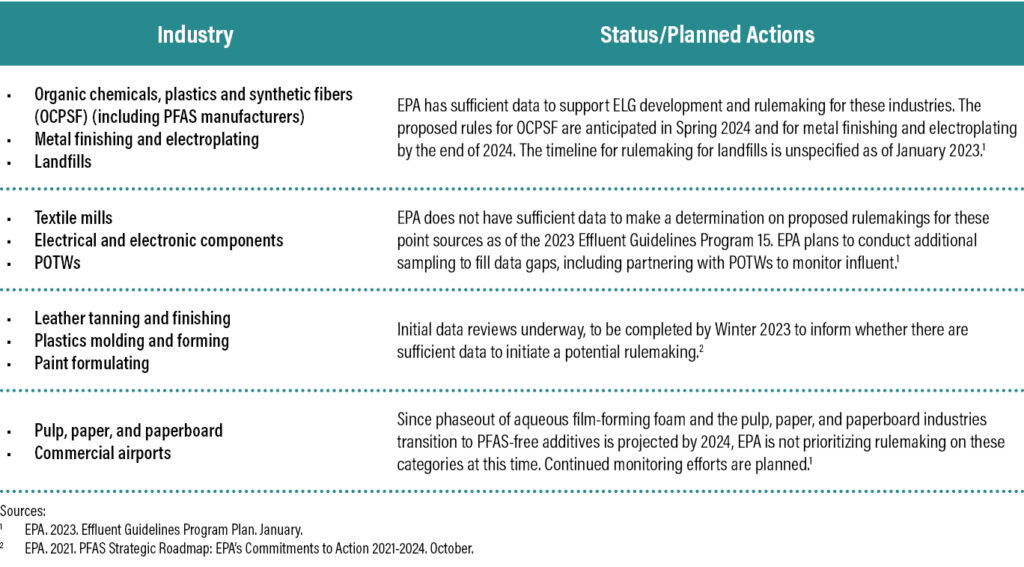The changing regulatory environment and state of the science focused on per- and polyfluoroalkyl substances (PFAS) and wastewater treatment can create uncertainties for municipal and industrial operators. The U.S. Environmental Protection Agency (EPA) issued a memorandum on 5 December 2022 to all 10 EPA Regions titled: Addressing per- and polyfluoroalkyl substances (PFAS) discharges in National Pollutant Discharge Elimination System (NPDES) Permits and through the Pretreatment Program and Monitoring Programs. The NPDES program was established by the Clean Water Act (CWA) to address water pollution at its source by regulating discharges to waters of the United States.

The memorandum provides regulating agencies direction on how existing permitting authorities can be used to help identify upstream sources of PFAS with the latest sampling analysis methods and leverage monitoring information to develop technology-based effluent limits to reduce industrial facility-specific PFAS discharges. The memorandum also provides recommendations, listed below, to publicly owned treatment works (POTWs) and industrial facility direct dischargers for monitoring, pollution reduction strategies, and public notification guidance for Draft Permits with PFAS-Specific Conditions to potentially affected downstream public water systems.
Industrial Direct Dischargers
- Effluent and wastewater residuals monitoring using EPA Draft Method 1633 for 40 PFAS (to be conducted at least quarterly) and Draft Adsorbable Organic Fluorine CWA Wastewater Method 1621 can be used in conjunction with Draft Method 1633, if appropriate.
- Best Management Practices (BMPs) for discharges of PFAS, including product substitution, reduction, or elimination of PFAS and provide annual reports.
BMPs to address PFAS-containing firefighting foams for stormwater permit. - Permit limits, including site-specific technology-based effluent limits for PFAS discharges developed on a best professional judgment basis for facilities for which there are no applicable effluent guidelines, as well as water quality-based effluent limits as derived from state water quality standards.
POTWs
- Effluent, influent, and biosolids monitoring using EPA Draft Method 1633 for 40 PFAS (to be conducted at least quarterly) and Draft Adsorbable Organic Fluorine CWA Wastewater Method 1621 can be used in conjunction with Draft Method 1633, if appropriate.
- Pretreatment program activities such as Industrial user inventory updates, control mechanisms such as BMPs, or local limits for industrial users and other pollution prevention measures.
- Permitting authority works with POTWs to reduce the amount of PFAS chemicals in biosolids using Draft Method 1633 to analyze biosolids.
EPA has outlined in its PFAS Strategic Roadmap milestones (see EA’s interactive timeline of major milestones of the Roadmap) for Effluent Limitations Guideline (ELG) development for industrial categories listed below by 2024 to inform permit limits.

In addition to the December 2022 EPA Memorandum and impending categorical ELG development milestones, EPA is planning to take the following actions within the next 2 years that may also have regulatory implications for POTWs, industrial discharges, biosolids, or treatment residuals management:
- Publish Ambient Water Quality Criteria for perfluorooctanoic acid (PFOA) and perfluorooctanesulfonic acid (PFOS) in surface water for the protection of aquatic life (Winter 2022)
- Finalize drinking water maximum contaminant levels for PFOA and PFOS (Fall 2023)
- Designate PFOA and PFOS as hazardous substances under the Comprehensive Environmental Response, Compensation, and Liability Act (CERCLA) (Summer 2023)
- Publish guidance on destruction and disposal of PFAS and PFAS-containing materials (Fall 2023)
- Finalize risk assessment for PFOA and PFOS in biosolids (Winter 2024)
- Publish Ambient Water Quality Criteria for PFOA and PFOS in surface water for the protection of human health (Fall 2024)
How Do These EPA Actions Affect You?
Since certain industrial facility discharges or treatment residuals and nearly all POTW effluent and biosolids typically contain some measure of PFAS that can be introduced into the environment, these EPA actions will affect the ways regulated facilities monitor and manage their effluents and treatment-related solids.
Conceptual Site Model for PFAS in POTWs

POTWs do not generate PFAS; however, the waste streams they accept may contain PFAS and PFAS precursors that can be transformed into some of the higher profile, persistent, and toxic PFAS such as PFOA and PFOS during the treatment process. Industrial dischargers who use or manufacture one of the more than 600 PFAS in commerce today have not been historically required to monitor for these substances in effluents or treatment residuals. Similarly, landfill leachates that are discharged to POTW contain measurable amounts of PFAS. Even if the POTW influent is predominantly residential, PFAS are contained in a wide variety of commercial items and household chemicals that when discarded may reach sanitary and stormwater discharges.
Conventional POTWs that receive industrial pretreatment, commercial, stormwater, and residential discharges that contain PFAS are not effectively configured to remove PFAS from influent that they receive. Likewise, nearly 50% of all biosolids generated from POTWs nationwide are land-applied for agricultural purposes, which may also contain measurable levels of PFAS. Land application of biosolids containing PFAS may enter the food chain through uptake in agricultural crops, leach to groundwater, or degrade local watershed quality from runoff.
As regulating authorities begin to incorporate PFAS-specific conditions into the draft permits, affected facilities will be required to monitor and potentially treat process waters or effluents for certain PFAS. Industrial dischargers may need to evaluate treatment options or process modifications to reduce PFAS loading. POTWs will leverage pretreatment program authorities to identify upstream point sources and set discharge limits as the first course of action to reduce PFAS loadings.
PFAS and Wastewater Treatment – Next Steps
Better understanding of your utility’s influent/effluent characteristics, treatment process, and current residuals or biosolids management practices in the context of rapidly evolving local and federal regulations will assist and inform the risk management decision-making process. Our team works with facility operators to assess potential environmental liabilities associated with effluents, biosolids, or treatment residuals that contain PFAS. EA subject matter experts in the fields of sampling/analysis, environmental fate and risk assessment, and treatment are actively partnering with academia, federal and state agencies, and industry to advance PFAS science so that we can bring practical engineered solutions to your facility. Examples of next steps include:

Learn more about EA’s sEAmless configurable compliance portal and our ecotoxicology and treatability laboratories.
EA is developing a toolkit to help utilities manage their PFAS treatment residuals and waste streams with support from municipal and private wastewater and drinking water utilities and academic partners to optimize the toolkit. If your utility is interested in participating in the development of the toolkit please reach out to Mahsa Modiri-Gharehveran, PhD, PE for more information.
 For More Information Contact:
For More Information Contact:
Paul Caprio, P.G.
Vice President, Director, Chemicals and Contaminants of Emerging Concern
Contact Us
